Companion robots can be of great benefit to older adults. This is particularly true if they live alone. And as companion robots are becoming better quality and more affordable, adoption rates are increasing.
Top reasons seniors should consider a companion robot.
- Conversational interface minimizes (ideally eliminates) user need to learn device, it learns about them instead and becomes an assistant, with proactive engagement
- Addressing loneliness via video calls (or telepresence) and other ways of keeping in touch, and interacting, with family, friends, and community
- Available young child-oriented activities could lead to more frequent visits by grandchildren
- Ability to detect falls and other potential emergencies, and summon help
- Monitoring of activities (including reminders as necessary), immediate environment, and possibly vital signs for family peace of mind and predictive warnings
- Can assist caregivers, family and/or professional, with potential cost savings
- Integration of security, smart home (including entertainment system) control, and educational, instructive, informational features, providing a better quality of life
- Providing benefits for those with visual, hearing and cognitive impairment, such as reading books
What features do companion robots have?
All of the products that we consider provide a conversational interface. Several incorporate the ability to access apps. Here are the most common features by category:
Loneliness / social / connection
- Video calls or telepresence
- Games /apps for grand-kids
- Takes photos on request
- Records videos on request
- Functions to share (send/receive) messages, photos or videos with connections (friends/family)
- Capable of recognizing individuals and uses names during interactions
- Functions for the user to participate in established social networks
Safety & security
- Detection of falls or other emergencies (medical/environmental) and summons help
- Intrusion detection
- Night patrol of home
- View home when away, especially after an alert
- Environmental sensors
- Heat/smoke
Digital health
- Medications/pills
- Reminder
- Monitor
- Exercises
- Reminder
- Physical
- Mental/memory
- Medical/telehealth
Quality of life
- Smart home/home automation
- Assistance
- Project/view video
- Kitchen helper
- See who is at the door
- Alarm clock
- Calendar keeper
- Entertainment
- Read books
- Movies/TV shows
- Music
- Games
- Education/information
- News
- TED Talks
- General questions
- Lessons
What are the best companion robots available for seniors?
ElliQ from Intuition Robotics
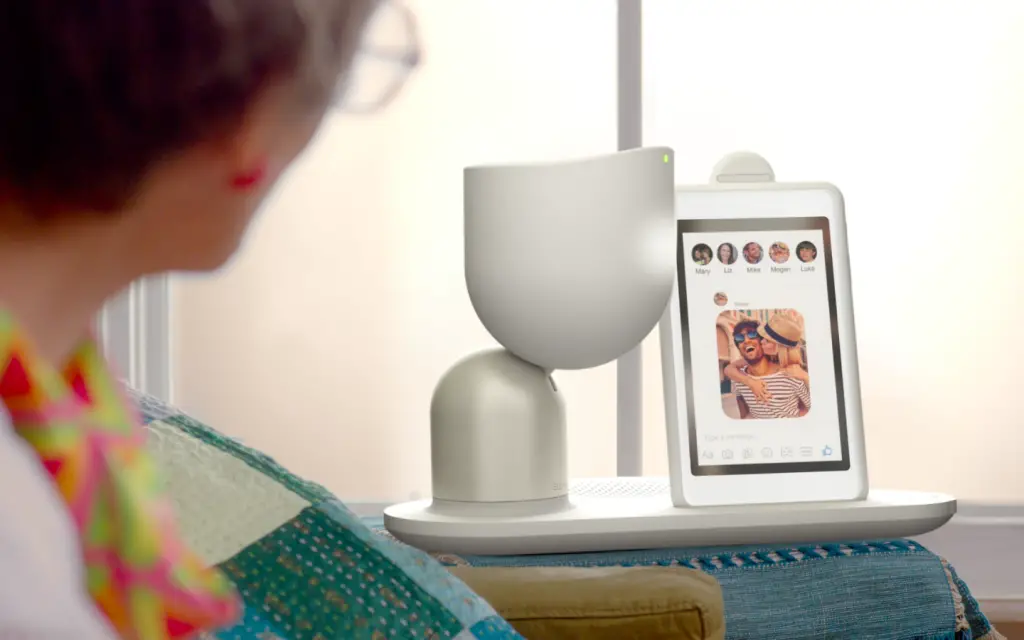
Intuition Robotics unveiled ElliQ in January 2017 as the first social robot developed specifically for the needs of older adults. The company’s focus is on creating a product that many seniors find a valuable aide and a comfortable member of their home as they face the challenges of aging. Or as they put it “proactive, context-aware, multi-modal and persona-based experiences”.
Three serial entrepreneurs founded this Israeli company. Notable companies such as iRobot, Toyota Research Institute, and Samsung’s investment fund, Next, are financial backers. Additionally, ElliQ was awarded a prestigious Innovation Award in the Smart Home category at CES (formerly the Consumer Electronics Show) in 2018.
ElliQ is available (at this writing) for $29.99 per month with an annual subscription and a $249.99 registration fee. Check out current pricing on the ElliQ site.
Watch this very short promotional video to learn more:
ElliQ is a stationary device with two parts, an expressive, through motion and lighting, non-humanoid robot, plus a removable tablet.
iPal Robot from Avatarmind
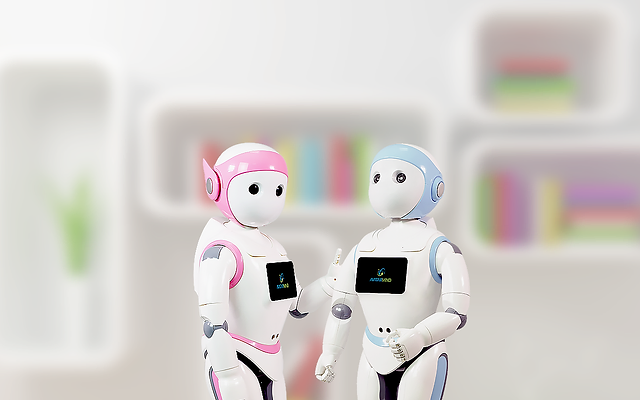
The iPal Robot, from the Chinese-American company AvatarMind, was introduced in China, with a focus on young children, in 2017. I met the CEO at the RoboBusiness Expo in September 2016, discussing my interest in the eldercare intentions for this social robot. I subsequently arranged for the presentation of iPal to my community’s technology committee in May 2017.
I had an early version on loan in my home for several months. I demonstrated it to a small group of residents in my community but it was not mature enough to be of interest.
The company is now listing Senior Companionship/Care first among the target uses, followed by Retail/Hospitality, and Children’s Education. However, it mainly offers iPal as a Robot Development Platform seeking partners to tailor it for specific uses.
iPal is a tall mobile social robot with a humanoid form. Availability for the U.S. is no longer stated, other than a developer version. But it is stated that partners are working on bringing it to market in the U.S. for eldercare applications.
Buddy from Blue Frog Robotics
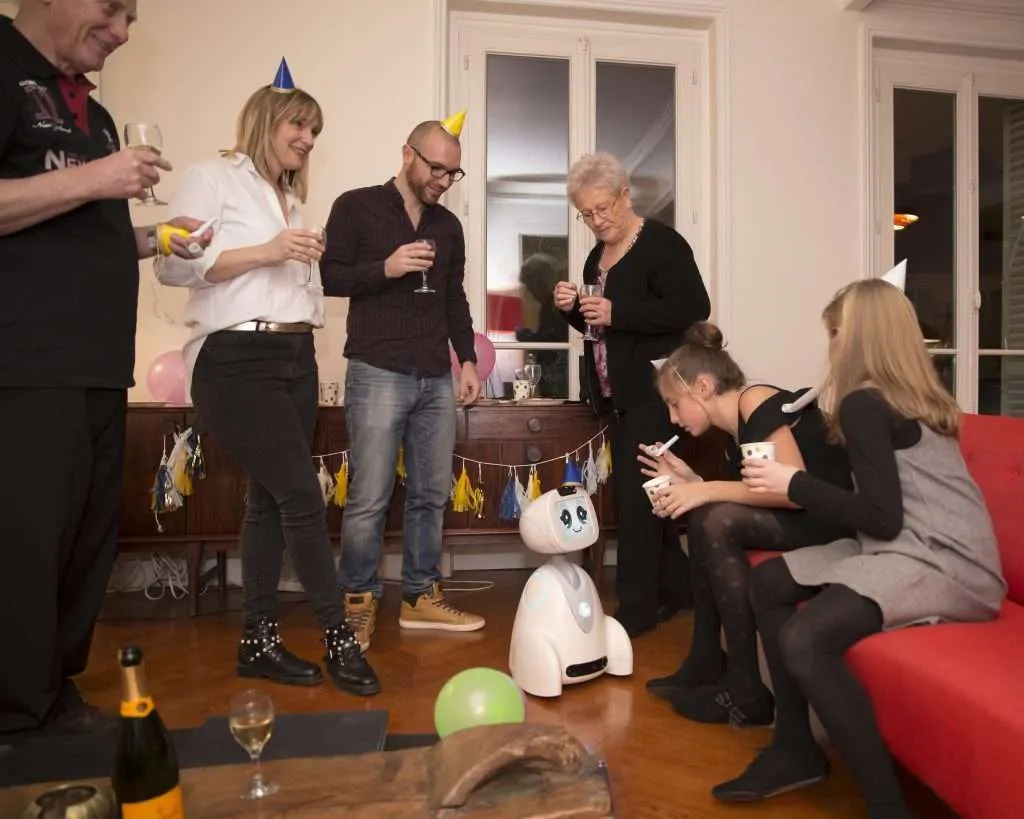
Buddy, “The Companion Robot” is from the French company Blue Frog Robotics. It is one of several social robot products introduced via crowdsourcing (notably Indiegogo and Kickstarter) – this one in 2015. As with many crowdsourced products, delivery to the initial “backers” was much later than initially promised, or, as in this case, has yet to occur. Crowdsourcing is not for the impatient! However, it also secured a new round of funding from a U.S. venture firm in late 2017.
Buddy is intended to serve the whole family, but the company does emphasize the benefits it offers for the elderly and their families. It is participating, along with several other European and Japanese firms, in a project to develop “solutions for extending active and healthy aging in daily life”.
Buddy is a short mobile social robot with a hybrid humanoid (“arms” are an option) form. The crowdsource price was $699 to $999, for the basic model and one with all options included.
temi personal robot
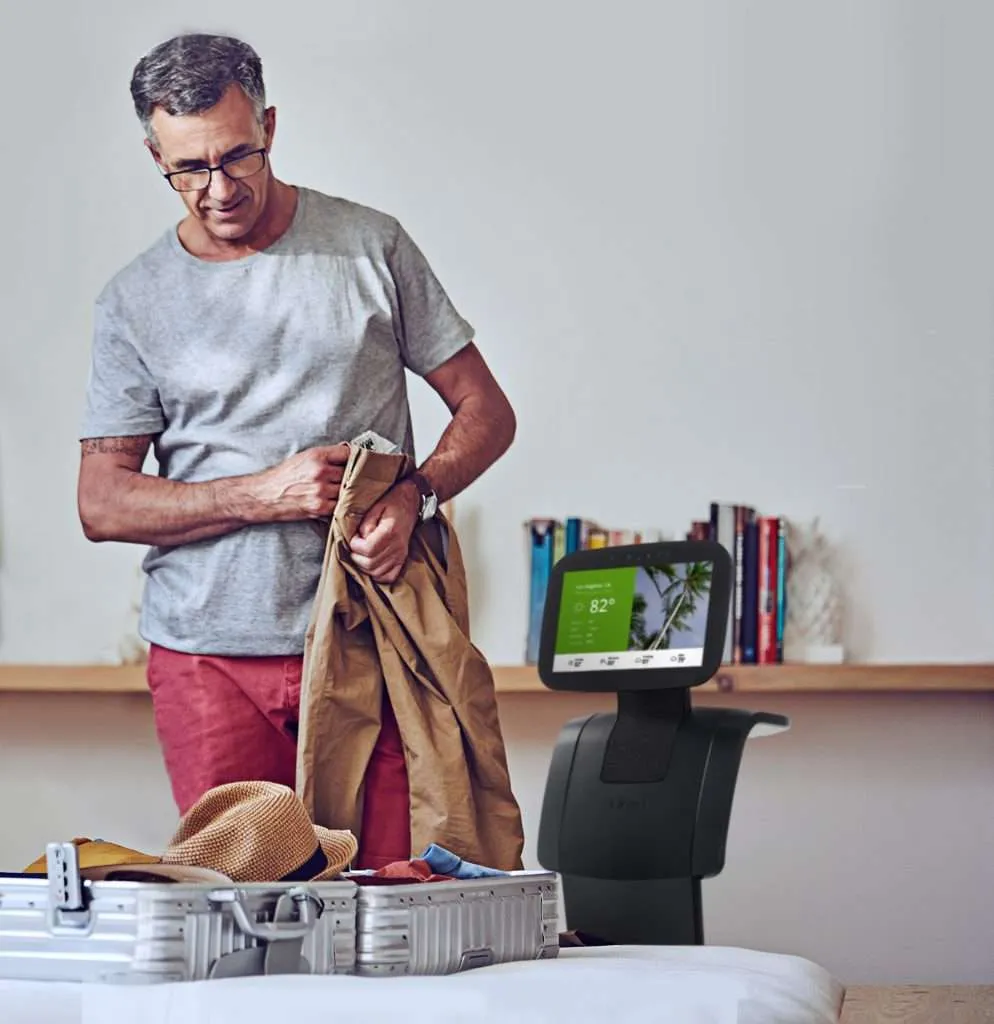
temi was formed in 2016 as a subsidiary of a very successful Israeli manufacturer of “tactical ground-based robots” for worldwide military and related uses. The company, Roboteam, is based in Maryland. It is reported that they are now separate companies.
temi the personal robot was inspired by a grandmother, with shaky hands, of one of the company’s founders. It received a $60 million investment and announced a three-year distribution deal in China for 100,000 units.
temi has been referred to as “Alexa on wheels” providing much of the same functionality plus its ability to recognize and follow users around. Telepresence is its primary focus. Because of grandma’s shaky hands, it has a tray to carry things placed there.
A fair amount of its features are applicable to seniors. For a deeper dive into temi’s features, read our article, The temi Robot: A Personal Companion for Aging in Place.
The company has gotten more than half a million followers on Facebook and has obtained a number of partners around the world. One of them, Medisana, is a leading digital healthcare company based in Germany which has introduced its Home Care Robot.
There are numerous other applications, beyond seniors, for families, individuals, businesses, healthcare, etc. that have emerged from extensive testing prior to, and real usage since, sales began.
temi is a tall mobile robot with a non-humanoid form. While it is not being developed as “social” it includes conversational assistance via Alexa or its own technology. It is considered a personal robot technology platform.
Ohmni Telepresence Robot
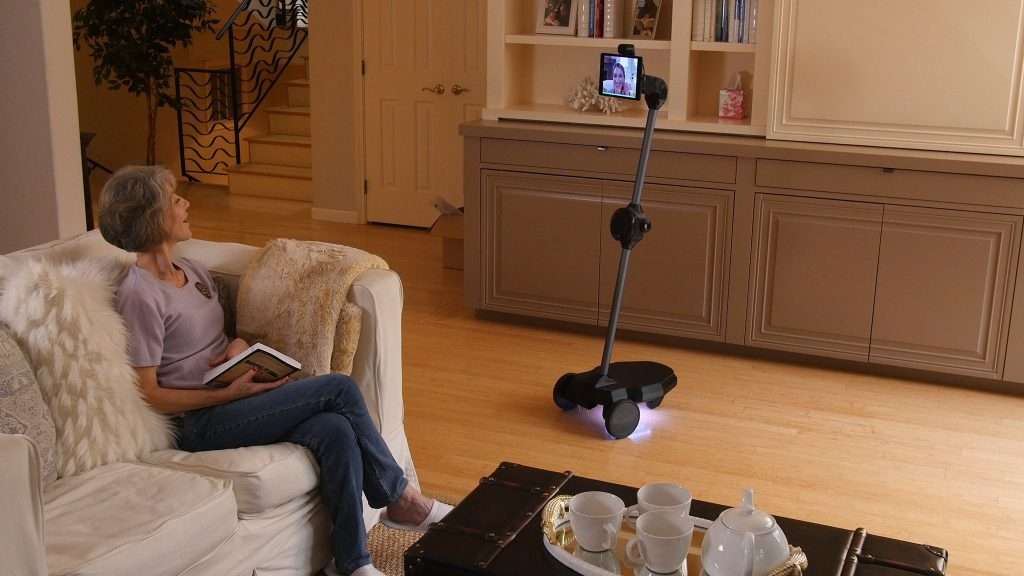
Ohmni, from Ohmnilabs, is a telepresence robot, mostly aimed at consumers, but also at home healthcare providers. The company had a successful crowdsourcing campaign in 2017 after raising some initial funding from investors.
It is included because of extensive testing with aging in place seniors and their families. I earlier attended a “Tech Talk – Living with Smart Robots” presented by a nearby progressive senior community organization where Ohmni was featured.
The company is located in Silicon Valley and uses “3D printing” for much of the manufacturing locally. Below is a 2 1/2 minute introductory video.
Ohmni provides a better experience than something like an Echo Show because of its mobility and other features. Two units are not a requirement, only an internet browser on any device. Requiring an App for most devices these days is usually a requirement, so this is somewhat unique.
Ohmni is a tall mobile telepresence robot. The company has mentioned the future possibility of adding Alexa type functionality and arms (no detail on what for). The second generation version was priced at $2,195.
Should you get a companion robot?
Keep reading for more general information about companion robots and why they might be the next best purchase you make.
What is a Companion Robot?

“For me, a social robot is first and foremost a companion. Yes, it’s smart, learns, has the ability to understand us and talk. It can perform all sorts of tasks on our behalf. But we have to be able to relate to it and feel like it can relate to us too.” wrote Amy Stapleton and I generally agree with her description.
Wikipedia offers a complex, academic, definition of a Social Robot. In addition to the definition above about companionship, and particularly for those in the early and late stages of life, there is a caring aspect. This means it assists humans that are responsible for providing care.
Additionally, and for those at other stages of life, the companion robot must provide useful functionality. Several underlying technologies have advanced to the point where I believe companion robots may soon become available to help us age in place better and longer.
How Much Companion Robots Cost?
So far, the stationary type tends to be priced comparable to high-end smartphones – in the range of $600 – $900.
Consumer-oriented mobile offerings are in the range of $900 to $2,500, with most $1,500 – $2,500. More expensive products are intended for institutional, not home, applications.
Someday, as with some other products, Medicare, or other insurance might cover the purchase. Today some insurance cost savings are available with the application of technology products because of a reduced risk of loss. As noted above, there are also potential cost savings for caregiver services.
Alternative strategies might become available. Look how many people are now getting a new smartphone every year, or two, via a subscription model. This makes sense given the rapid introduction of new capabilities and would make sense for social robots too.
When Will Companion Robots Be in Every Home?
Jibo, which was marketed as “the first social robot for the home”, became available for sale at the end of 2017. The first iPhone came out in 2007. In comparison, the social robot market is in its infancy.
As with the promise of driverless vehicles, there are both optimistic and pessimistic opinions to be found regarding when they will succeed.
Note that the first Amazon Echo (Alexa) was released 2014. It was the hit of the very important CES (formerly Consumer Electronics Show) of January 2017. According to a recent Smart Audio Report developed by NPR, in 2022 62% of Americans 18+ used a voice assistant, and those devices included: smart speakers, smartphones, TV remotes, in-car systems, a computer/laptop, and tablet, among others.
I am very optimistic about social robots.
Japan initially, but now China and Korea as well, began working (long ago) on social robots due to the higher population of seniors. They, along with quite a few other nations, also significantly invest in this area with government funding as those governments are responsible for healthcare.
Because portions of the U.S. healthcare industry has a vested interest, U.S. development is accelerating. The Obama administration had initiatives related to technology for “aging gracefully”, and robotics was one of the technologies being considered.






